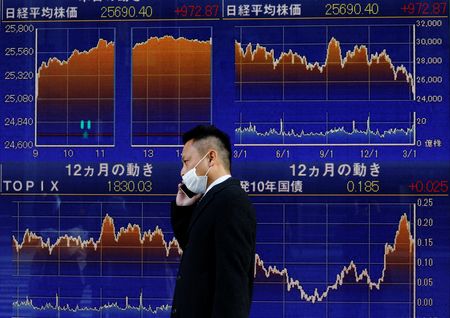
By Dhara Ranasinghe
LONDON (Reuters) – Oil prices slid on Monday as a coronavirus lockdown in Shanghai fueled worries about weak demand, while the yen’s stomach-churning descent continued as the Bank of Japan stood in the way of higher yields.
World stocks were largely flat, holding their ground in the face of another brutal selloff in major bond markets.
Ten-year U.S. Treasury yields pushed decisively above the 2.5%-marker for the first time since 2019, two-year bond yields in the Netherlands and Belgium turned positive for the first time since 2014 and even Japanese yields defied central bank intervention to hit fresh six-year highs.
The other eye-popping move came from the yen, which slid almost 1.5%.
China’s financial hub of 26 million people meanwhile told all firms to suspend manufacturing or have people work remotely in a two-stage lockdown over nine days.
The spread of restrictions in the world’s biggest oil importer saw Brent skid $4.35 to $116.33, while U.S. crude fell $4.5 or 4% to $109.38. [O/R]
Although Chinese blue chips shed 0.6% and Japan’s Nikkei lost 0.7%, and U.S. stock futures eased, weaker oil prices cheered European shares which were broadly firmer.
MSCI’s world stock index was flat,, resilient in the face of a radically more hawkish Federal Reserve and surging bond yields.
Risk sentiment was helped by hopes of progress in Russian-Ukranian peace talks to be held in Turkey this week after President Volodymyr Zelenskiy said Ukraine was prepared to discuss adopting a neutral status as part of a deal.
“Sentiment has been surprisingly resilient in stock markets, which are buying positive headlines from the war in Ukraine,” said Jan von Gerich, chief analyst at Nordea.
“The repricing that continues at the short end of the U.S. yield curve is taking place really fast and without any consequences for Wall Street at the moment.”
Citi last week forecast 275 basis points of Federal Reserve tightening this year including half-point hikes in May, June, July and September.
YIELD SURGE
Expectations that the Fed could push harder and faster to tame inflation running at four-decade highs continued to batter sovereign bond markets.
Two-year Treasury yields were up around 10 basis points in London trade, having hit their highest levels since early 2019 at 2.41%. Ten-year yields also rose to new highs above 2.5%.
And one measure of the U.S. bond yield curve — the gap between five and 30-year Treasury yields — inverted for the first time since 2006 in a sign that recession risks are increasingly being priced in.
Timothy Graf, State Street’s head of EMEA macro strategy, said selling bonds felt like “the path of least resistance right now.”
“The Fed’s given no sign it will slow down, if anything they have ratcheted up the hawkish guidance,” he added.
Euro zone bond markets continued their move into positive-yield territory, while money market pricing suggested investors were now anticipating 60 bps worth of rate hikes from the European Central Bank by year-end versus 50 bps last week.
Australia’s 3-year bond yield rose to 2.386%, its highest level since 2014.
Japan’s 10-year government bond rose to a fresh six-year high of 0.25%, reaching the upper limit of the Bank of Japan’s policy band even after the central bank stepped into the market in efforts to rein it in.
The BOJ reinforced its super-loose policy by offering to buy as many bonds as needed to keep 10-year yields under 0.25%.
That saw the dollar rise to its highest since August 2015 at 123.82 yen, giving it a gain of over 7% for the month. Likewise, the resource-rich Australian dollar has climbed more than 10% this month to reach 93.20 yen.
The euro has lost about 2.3% on the dollar in the same period, but at $1.0954 is some way above the recent two-year trough of $1.0804.
In commodity markets, gold softened to $1,931 an ounce, down about 1.3%.
(Reporting by Dhara Ranasinghe, Editing by William Maclean)

